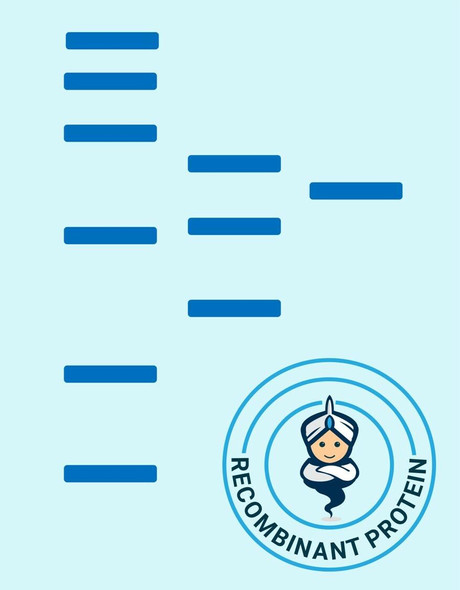Human L1CAM Recombinant Protein (RPPB3832)
- SKU:
- RPPB3832
- Product type:
- Recombinant Protein
- Size:
- 10ug
- Species:
- Human
- Target:
- L1CAM
- Synonyms:
- L1 Cell Adhesion Molecule
- Antigen Identified By Monoclonal Antibody R1
- N-CAM-L1
- NCAM-L1
- Source:
- Sf9 Insect cells
- Uniprot:
- P32004
Description
| Product Name: | Human L1CAM Recombinant Protein |
| Product Code: | RPPB3832 |
| Size: | 10µg |
| Species: | Human |
| Target: | L1CAM |
| Synonyms: | L1 Cell Adhesion Molecule, Antigen Identified By Monoclonal Antibody R1, N-CAM-L1, NCAM-L1, CAML1, MIC5, Neural Cell Adhesion Molecule L1, CD171 Antigen, N-CAML1, CD171, HSAS1, MASA, HSAS, SPG1, S10. |
| Source: | Sf9 Insect cells |
| Physical Appearance: | Sterile filtered colorless solution. |
| Formulation: | L1CAM protein solution (0.25mg/ml) contains Phosphate Buffered Saline (pH 7.4) and 10% glycerol. |
| Stability: | Store at 4°C if entire vial will be used within 2-4 weeks. Store, frozen at -20°C for longer periods of time. For long term storage it is recommended to add a carrier protein (0.1% HSA or BSA).Avoid multiple freeze-thaw cycles. |
| Purity: | Greater than 90.0% as determined by SDS-PAGE. |
| Amino Acid Sequence: | IQIPEELMEP PVITEQSPRR LVVFPTDDIS LKCEASGKPE VQFRWTRDGV HFKPKEELGV TVYQSPHSGS FTITGNNSNF AQRFQGIYRC FASNKLGTAM SHEIRLMAEG APKWPKETVK PVEVEEGESV VLPCNPPPSA EPLRIYWMNS KILHIKQDER VTMGQNGNLY FANVLTSDNH SDYICHAHFP GTRTIIQKEP IDLRVKATNS MIDRKPRLLF PTNSSSHLVA LQGQPLVLEC IAEGFPTPTI KWLRPSGPMP ADRVTYQNHN KTLQLLKVGE EDDGEYRCLA ENSLGSARHA YYVTVEAAPY WLHKPQSHLY GPGETARLDC QVQGRPQPEV TWRINGIPVE ELAKDQKYRI QRGALILSNV QPSDTMVTQC EARNRHGLLL ANAYIYVVQL PAKILTADNQ TYMAVQGSTA YLLCKAFGAP VPSVQWLDED GTTVLQDERF FPYANGTLGI RDLQANDTGR YFCLAANDQN NVTIMANLKV KDATQITQGP RSTIEKKGSR VTFTCQASFD PSLQPSITWR GDGRDLQELG DSDKYFIEDG RLVIHSLDYS DQGNYSCVAS TELDVVESRA QLLVVGSPGP VPRLVLSDLH LLTQSQVRVS WSPAEDHNAP IEKYDIEFED KEMAPEKWYS LGKVPGNQTS TTLKLSPYVH YTFRVTAINK YGPGEPSPVS ETVVTPEAAP EKNPVDVKGE GNETTNMVIT WKPLRWMDWN APQVQYRVQW RPQGTRGPWQ EQIVSDPFLV VSNTSTFVPY EIKVQAVNSQ GKGPEPQVTI GYSGEDYPQA IPELEGIEIL NSSAVLVKWR PVDLAQVKGH LRGYNVTYWR EGSQRKHSKR HIHKDHVVVP ANTTSVILSG LRPYSSYHLE VQAFNGRGSG PASEFTFSTP EGVPGHPEAL HLECQSNTSL LLRWQPPLSH NGVLTGYVLS YHPLDEGGKG QLSFNLRDPE LRTHNLTDLS PHLRYRFQLQ ATTKEGPGEA IVREGGTMAL SGISDFGNIS ATAGENYSVV SWVPKEGQCN FRFHILFKAL GEEKGGASLS PQYVSYNQSS YTQWDLQPDT DYEIHLFKER MFRHQMAVKT NGTGRVRLPP AGFATELEHH HHHH |
L1 Cell Adhesion Molecule (L1CAM) which is a cell adhesion receptor of the immunoglobulin superfamily takes part in nerve cell function. L1CAM is a neural cell adhesion molecule involved in the dynamics of cell adhesion and in the generation of transmembrane signals at tyrosine kinase receptors. L1CAM takes part in cell migration, neurite outgrowth and myelination. Furthermore, L1CAM plays an important role in the dynamics of neuronal structure and function in the mature brain.
L1CAM Human Recombinant produced in Sf9 Baculovirus cells is a single, glycosylated polypeptide chain containing 1104 amino acids (20-1115a.a.) and having a molecular mass of 123.6kDa (Molecular size on SDS-PAGE will appear at approximately 100-150kDa). L1CAM is expressed with a 8 amino acids His tag at C-Terminus and purified by proprietary chromatographic techniques.
| UniProt Protein Function: | Neural cell adhesion molecule involved in the dynamics of cell adhesion and in the generation of transmembrane signals at tyrosine kinase receptors. During brain development, critical in multiple processes, including neuronal migration, axonal growth and fasciculation, and synaptogenesis. In the mature brain, plays a role in the dynamics of neuronal structure and function, including synaptic plasticity. |
| NCBI Summary: | The protein encoded by this gene is an axonal glycoprotein belonging to the immunoglobulin supergene family. The ectodomain, consisting of several immunoglobulin-like domains and fibronectin-like repeats (type III), is linked via a single transmembrane sequence to a conserved cytoplasmic domain. This cell adhesion molecule plays an important role in nervous system development, including neuronal migration and differentiation. Mutations in the gene cause X-linked neurological syndromes known as CRASH (corpus callosum hypoplasia, retardation, aphasia, spastic paraplegia and hydrocephalus). Alternative splicing of this gene results in multiple transcript variants, some of which include an alternate exon that is considered to be specific to neurons. [provided by RefSeq, May 2013] |
| UniProt Code: | P32004 |
| NCBI GenInfo Identifier: | 1705571 |
| NCBI Gene ID: | 3897 |
| NCBI Accession: | P32004.2 |
| UniProt Secondary Accession: | P32004,Q8TA87, A0AV65, A4ZYW4, B2RMU7, G3XAF4, |
| UniProt Related Accession: | P32004 |
| Molecular Weight: | 138,908 Da |
| NCBI Full Name: | Neural cell adhesion molecule L1 |
| NCBI Synonym Full Names: | L1 cell adhesion molecule |
| NCBI Official Symbol: | L1CAM |
| NCBI Official Synonym Symbols: | S10; HSAS; MASA; MIC5; SPG1; CAML1; CD171; HSAS1; N-CAML1; NCAM-L1; N-CAM-L1 |
| NCBI Protein Information: | neural cell adhesion molecule L1 |
| UniProt Protein Name: | Neural cell adhesion molecule L1 |
| UniProt Synonym Protein Names: | CD_antigen: CD171 |
| Protein Family: | Neural cell adhesion molecule |
| UniProt Gene Name: | L1CAM |










